-
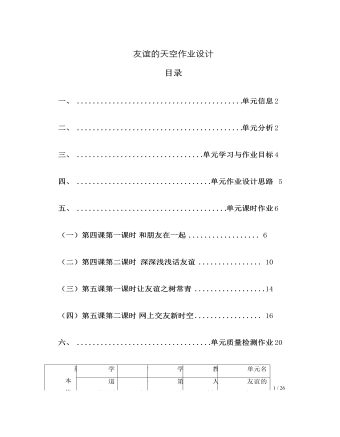
初中道德与法治七年级上册友谊的天空4作业设计
(1) 请结合所学知识,谈谈你对“幸福、幸运”的理解。【看法二】小李:“我最近和好朋友发生了矛盾,考试时他问我答案,我拒绝 了他,他很生气。拒绝给他答案,我这样做是不是做错了?我感觉我们两个 人已经渐行渐远了,我该怎么办?”(2) 面对小李的苦恼,你会如何开导、安慰他?【看法三】小王:“我身边很多同学都是通过送礼物、花钱请吃饭来巩固友情 的,要不我也模仿他们吧。”(3) 花钱请客吃饭能买到真正的友谊吗?请运用所学知识谈谈你的理解。12. (原创题)阅读材料,回答下列问题。七年级学生肖楠在交友遇到了很多困扰:困扰一:我发现好朋友小鹏愁眉苦脸,关心地上前询问原因,可小鹏怎么也 不肯说,还对我很不耐烦。困扰二:我和网友轻舞飞扬在网上认识一年多,很投缘,他想要我的照片, 想知道我的姓名、学校、家庭住址等信息,还想约我周末见面。
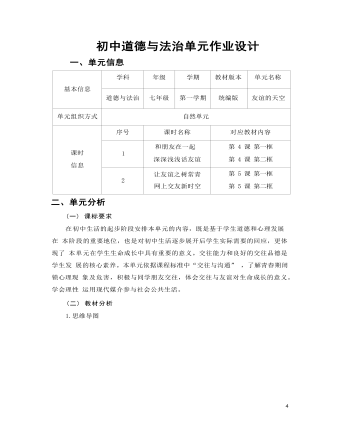
初中道德与法治七年级上册友谊的天空14作业设计
A.因为朋友,我们感受到自己的价值B.因为朋友,我们感受到友谊的力量C.因为朋友,我们获得了更多的荣誉D.因为朋友,我们会乐于并尝试学习9.朋友之间需要忠诚和信任,但是,这并不意味着朋友之间就应该毫无保留。我们关心和帮助朋友,但不要替朋友作决定。由此可见 ( )A.呵护友谊,需要给对方一些空间B.呵护友谊,需要用心体会对方的需要C.冲突发生时,要相互协调和宽容D.友谊的力量让我们得到健康的成长10.七年级的乐乐同学迷上网络游戏后,学习成绩一落千丈。他从此变得孤僻,不爱说话,易发脾气。后来,他的同桌亮亮与他交往,和他做朋友,他们经 常一起做作业、讨论问题,一起打球。乐乐慢慢远离网络游戏,学习勤奋了,有进步了,性格变得开朗了。这一事例表明 ( )A.友谊帮助我们认识和改正自己言行中的缺失,使人进步B.友谊使人远离网络C.朋友可以改变人的一切D.朋友使我们对任何事情都敢去尝试
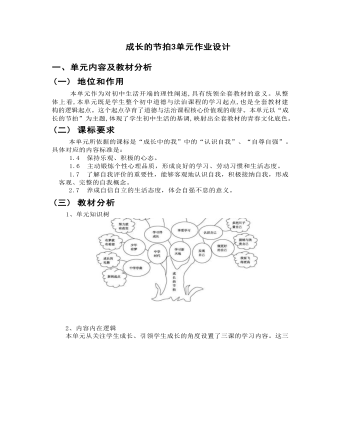
初中道德与法治七年级上册成长的节拍3作业设计
( 一) 活动步骤1.全班分为4 各小组:绘画组, 日记组,网络组,实践组。每个小组设置 1 名小组长。 我列出了四项作业供每个学习小组选做,之后课上分享展示学习成果。(1) 调查中学时代对一个人的重要性或者人生影响 (可以调查周围的亲朋好友 也可以调查小区的人) 。调查结果写心得体会或者写报告,深刻认识到中学时代 对一个人的重要性。 (实践组)(2) 走出安逸区,真正的成长是有艰辛和汗水造就的,列出自己的目标、学习 习惯的行动和计划。对自己的学习习惯进行深刻分析后制订了习惯养成计划表, 每天对照执行。学生可以请求同学和家长经常提醒、监督自己,以养成良好的习 惯,改正缺点,做更好的自己,实现自己的目标。 (绘画组)(3) 编写自己的成长手册 (自评、他评、老师评价) ,记录你的奋斗目标你的 想法和创意,让他见证和助推你的成长。 ( 日记组)(4) 负责记录,拍照,将活动内容传到 QQ 群里,写这一单元的活动小报。 (网 络组)(二) 时间要求:15 分钟
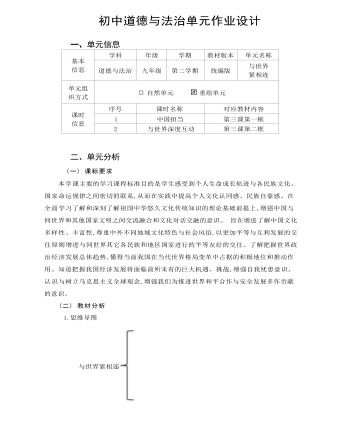
九年级下册道德与法治世界舞台上的中国1作业设计
A.大力深化大数据、人工智能等研发应用B.高举新时代改革开放旗帜,继续全面深化改革、全面扩大开放C.加强国际交流与合作,培育竞争新优势D.建立更加公平、更可持续的社会保障制度 2、发展是解决我国一切问题的基础和关键。全面建设社会主义现代化国家,必须始终抓好发展 这个基础和关键。中国积极谋求发展,就必须 ( )①引领、主导全球规则的制定②要加快构建以国内大循环为主体、国内国际双循环相互促进的新发展格局③掌握国际竞争主动权④积极寻求新的经济增长点A. ①②③ B.①②④ C.①③④ D.②③④3、“中国制造2025”构想的提出,对于中国传统制造业的转型升级影响深远。新一代信息技术 和传统工业的深度融合已成为中国新一轮制造发展制高点,我们要把智能制造作为中国制造未 来的主攻方向,实现由“中国制造”向“中国创造”“中国智造”转型。这有利于 ( )①促进我国经济实现由实体经济向虚拟经济转变②通过新技术将传统产业打造为高新技术产业③推动传统产业优化升级,从而进一步提升我国在全球分工中的地位④催生新兴产业,形成新的经济增长点
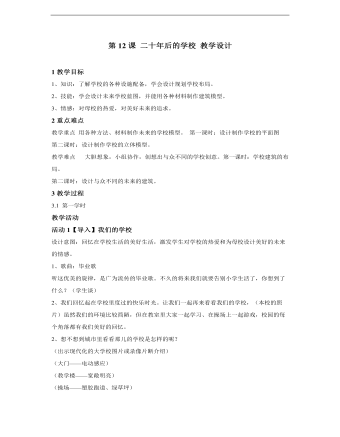
小学美术人教版六年级下册《第12课二十年后的学校》教学设计
2重点难点教学重点用各种方法、材料制作未来的学校模型。第一课时:设计制作学校的平面图第二课时:设计制作学校的立体模型。教学难点大胆想象,小组协作,创想出与众不同的学校创意。第一课时:学校建筑的布局。第二课时:设计与众不同的未来的建筑。3教学过程3.1 第一学时
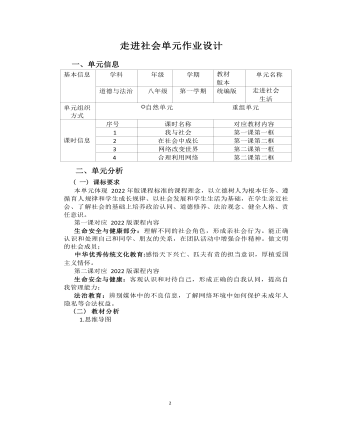
道德与法治八年级上册进社会作业设计
二、单元分析( 一) 课标要求本单元体现 2022 年版课程标准的课程理念,以立德树人为根本任务、遵 循育人规律和学生成长规律、以社会发展和学生生活为基础,在学生亲近社 会、了解社会的基础上培养政治认同、道德修养、法治观念、健全人格、责 任意识。第一课对应 2022 版课程内容生命安全与健康部分:理解不同的社会角色,形成亲社会行为。能正确 认识和处理自己和同学、朋友的关系,在团队活动中增强合作精神。做文明 的社会成员;中华优秀传统文化教育:感悟天下兴亡、匹夫有责的担当意识,厚植爱国 主义情怀。第二课对应 2022 版课程内容生命安全与健康:客观认识和对待自己,形成正确的自我认同,提高自 我管理能力;法治教育:辨别媒体中的不良信息,了解网络环境中如何保护未成年人 隐私等合法权益。
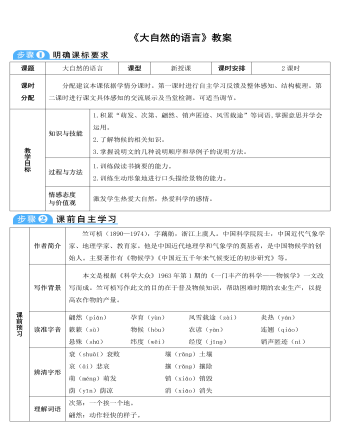
部编版语文八年级下册《大自然的语言》教案
结束这节课,我心里很轻松,因为在以往的教学中学生感觉到:说明文很单调、枯燥不生动。而本节课学生与我配合得非常好,原因是我利用多媒体展示的几幅画面,把学生的注意力都集中在所讲的内容中,并且调动了学生学习的积极性,认为物候现象就在我们的身边,激发学生探索科学奥秘的兴趣,更多地去了解大自然,认识大自然,热爱大自然。在初读课文的时候,我训练了学生的概括能力;在分清举例说明的方法时,让学生明白什么是举例子的说明方法;在细读课文的时候,让学生学习生动地有条理地说明事物的方法,还重点品味第一段的生动语言,在品味说明文语言的准确性时,有日常生活中的例子导入,深入浅出地讲解了说明语言准确性的两点情况。
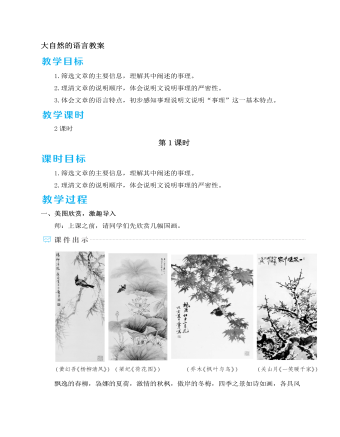
人教部编版语文八年级下册大自然的语言教案
【设计意图】学习事理说明文,要让学生在自主归纳的过程中,初步感知事理说明文说明“事理”这一基本特点,把握事理说明文和事物说明文的不同之处。引导学生通过学习课文,对科学方法产生自己的体会,并运用到自己的思考中。四、总结存储1.教师小结本文是一篇事理说明文,作者把一门科学——物候学介绍得浅显易懂,饶有趣味。全文采用逻辑顺序说明,思路清晰明了:描述物候现象——做出科学解释——追究因果关系——阐述研究意义。这种从现象到本质的认识方法和行文思路值得我们学习。本文语言严谨而生动,兼具说明的科学性和生动性,是一篇极有价值的科普文,是科学家竺可桢科学精神和科学思想的具体体现。文章启发我们:科学距离我们并不遥远,就在我们的身边,而想要探索它,就要有科学精神,扩大科学知识储备,掌握科学方法,勇于探索科学奥秘。
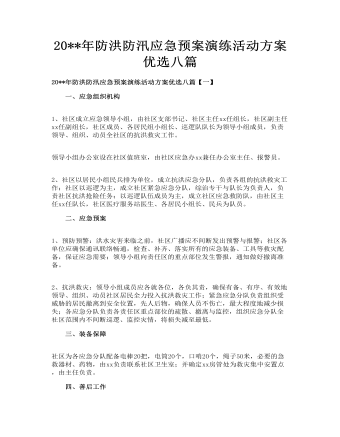
防洪防汛应急预案演练活动方案优选八篇防洪防汛应急预案演练活动方案优选八篇
二、应急预案 1、预防预警:洪水灾害来临之前,社区广播应不间断发出预警与报警;社区各单位应确保通讯联络畅通,检查、补齐、落实所有的应急装备、工具等救灾配备,保证应急需要;领导小组向责任区的重点部位发生警报,通知做好撤离准备。 2、抗洪救灾:领导小组成员应各就各位,各负其责,确保有备、有序、有效地领导、组织、动员社区居民全力投入抗洪救灾工作;紧急应急分队负责组织受威胁的居民撤离到安全位置,先人后物,确保人员不伤亡,最大程度地减少损失;各应急分队负责各责任区重点部位的疏散、撤离与监控,组织应急分队全社区范围内不间断巡逻、监控灾情,将损失减至最低。
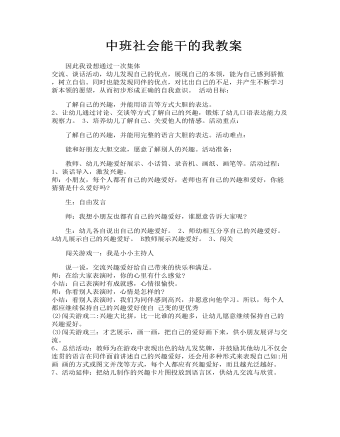
能干的小手中班教案中班社会能干的我教案
1、谈话导入,激发兴趣。 师:小朋友,每个人都有自己的兴趣爱好,老师也有自己的兴趣和爱好,你能猜猜是什么爱好吗? 生:自由发言 师:我想小朋友也都有自己的兴趣爱好,谁愿意告诉大家呢? 生:幼儿各自说出自己的兴趣爱好。 2、师幼相互分享自己的兴趣爱好。A幼儿展示自己的兴趣爱好。 B教师展示兴趣爱好。 3、闯关 闯关游戏一:我是小小主持人
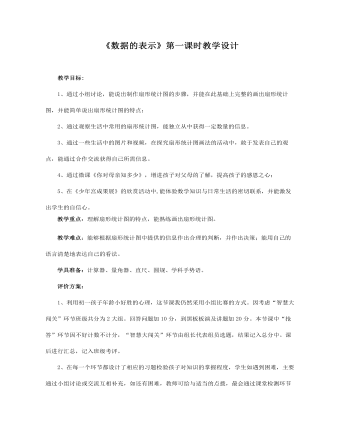
数据的收集与整理 3 数据的表示教案教学设计
创设情境,导入新课:你对母亲知多少师问1:我们5月份刚过了一个重要的节日,你知道是什么吗?----母亲节。师问2:那你知道妈妈的生日吗?(举手示意),每个妈妈都知道自己孩子的生日,请不知道的同学回家了解一下,多关心一下自己的父母。师问3:那你知道妈妈最爱吃的菜吗?你可以选择知道、不知道或者是没有爱吃的(拖动白板上相对应的表情符号)。请大家用不同的手势表示出来。我找3名同学统计各组的数据,写在黑板上(随机找3名学生数人数)。下面我来随机采访一下:你妈妈最喜欢吃的菜是什么?(教师随机采访,结合营养搭配和感恩教育)

新人教版高中英语必修3Unit 1 Festivals and celebrations-Discovering Useful Structure教学设计
4.That was an experience that frightened everyone. →That was _____________________. 答案:1. taking 2. being discussed 3. in the reading room 4. a frightening experienceStep 6 The meaning and function of V-ing as the predicative动词-ing形式作表语,它通常位于系动词后面,用以说明主语“是什么”或“怎么样”一种表示主语的特质、特征和状态, 其作用相当于形容词; 另一种具体说明主语的内容, 即主语等同于表语, 两者可互换。The music they are playing sounds so exciting. 他们演奏的音乐听起来令人激动。The result is disappointing. 结果令人失望。Our job is playing all kinds of music. 我们的工作就是演奏各种音乐。Seeing is believing. 眼见为实。Step 7 Practice1. It is ________(amaze) that the boy is able to solve the problem so quickly.2. Buying a car is simply _______(waste) money. 3. Please stop making the noise—it’s getting ________(annoy). 4. complete the passage with the appropriate -ing form.La Tomatina is a festival that takes place in the Spanish town Bunol every August. I think many food festivals are __________ because people are just eating. however, this festival is _________ because people don't actually eat the tomatoes. Instead, they throw them at each other! the number of people ________ part in this tomato fight, can reach up to 20,000, and it is a very __________ fight that lasts for a whole hour. The _______ thing is how clean Bunol is after the tomatoes are washed away after the fight. this is because the juice form tomatoes is really good for making surfaces clean!答案:1. amazing 2. wasting 3. annoying4. boring interesting taking exciting amazing

新人教版高中英语必修3Unit 1 Festivals and Celebrations-Listening &Speaking&Talking教学设计
The theme of this section is “Talk about festival activities and festival experiences”.Festival and holiday is a relaxing and interesting topic for students. This part talks about the topic from the daily life of students’. In the part A ---Listening and Speaking, there are three conversations among different speakers from three countries(Japan, Rio and China), where the speakers are participating in or going to participate in the festivals and celebrations. So listening for the relationship among them is a fundamental task. Actually, with the globalization and more international communication, it is normal for Chinese or foreigners to witness different festivals and celebrations in or out of China. In the Conversation 1, a foreign reporter is interviewing a Japanese young girl who just had participated in the ceremony of the Coming-of-Age Day on the street and asking her feeling about the ceremony and the afterwards activities. Conversation 2, Chinese girl Li Mei is witnessing the Rio Carnival for the first time, and her friend Carla gives her some advice on the costumes which enables her to match with the carnival to have a good time. Conversation 3, a Chinese guide is showing a group of foreign visitors around the Lantern Festival and introducing the customs of the festival to them. The three conversations have a strong vitality and insert the festival and cultural elements from different countries. So perceiving the festivals and cultures from different countries is the second task. At the same time, the scripts also insert the targeted grammar --- v-ing as attributive and predicative, which students can perceive and experience in a real context and make a road for the further study. That is the third task. In the Part B--- Listening and Talking, the theme is “Talk about festival experience”, which is the common topic in our daily conversations. During the conversation, Song Lin, a Chinese student, asked Canadian friend Max about how to spend Christmas. In the conversation, Song Lin talked about experience and the feelings during the Chinese Spring Festival, during which there are not only some enjoyable things but some unpleasant things. After the listening, perhaps students find there are some similarities between Christmas and the Chinese Spring Festival as there are some differences in the origins and celebrations. For example, people always visit friends and relatives, decorate their houses, have a big dinner together, chat and give presents to each other.

新人教版高中英语必修3Unit 1 Festivals and Celebrations-Reading for Writing教学设计一
The topic of this part is “Write about your festival experience”.During the Listening and Speaking and Talking, students are just asked to say out their festival experiences such as the Spring Festival, Mid-autumn Day, but this part students will be asked to write down their own festival experiences. During the reading part, it introduces the Naadam Festival in Inner Mongolia Autonomous Region, which can give students a good example to imitate. Students not only learn the festival, but touch and feel the Inner Mongolian’s character, the spirit and cultural atmosphere, which can help students form the cultural awareness and learn to enjoy and value the diversity of Chinese culture.Concretely, the dairy tells the experience that the author spent the Naadam Festival in Inner Mongolia Autonomous Region with his/her friend. The structure is clear. In the opening paragraph, it introduces the topic of the Naadam Festival and the whole feeling. Then it introduces the items of the festival like the ceremony, wrestling and horse racing. Finally, it summarizes this experience. Because this part is a travel journal, we must guide students pay more attention to these details: 1. use the first person. 2. use the past tense to tell the past thing and use the present or future tense to describe the scenery. 3. use the timeline to tell the development. 4. be careful for the author’s psychology, emotion and feeling, etc.1. Read quickly to get main idea; read carefully to get the detailed information about Naadam Festival.2. Learn the structure of the reading article and language.3. Write an article about a festival experience4. Learn to use the psychology, emotions and feeling in the writing.1. Write an article about a festival experience.2. Use the structure of the reading article and language.

新人教版高中英语必修3Unit 2 Morals and Virtues-Listening &Speaking&Talking教学设计
Example:One day, a poor boy who was trying to pay his way through school by sending newspapers door to door found that he only had one dime(一角)left. He was so hungry that he decided to beg for a meal at the next house.However, he lost his nerve when a lovely young woman opened the door. Instead of a meal he asked for a drink of water. She thought he looked hungry so she brought him a large glass of milk. He drank it slowly, and then asked, “How much do I owe you?” “You don’t owe me anything,” she replied, “Mother has taught me never to accept pay for a kindness.” “Then I thank you from the bottom of my heart.” With these words, Howard Kelly left that house.Years later the woman became badly ill and was finally sent to the hospital in a big city. Dr. Howard Kelly, now famous, was called in. When he heard the name of the town she came from, a strange light filled his eyes. Dressed in his doctor’s clothes, Dr. Kelly went into her room and recognized her at once. From that day on, he gave special attention to her, and decided to do his best to save her life.At last the woman was saved. Dr. Kelly asked the business office to pass the final bill to him. He looked at it and then wrote something on the side. The bill was sent to the woman’s room. She was afraid to open it because she was sure that it would take the rest of her life to pay for it off. Finally she looked, and the note on the side of the bill caught her attention. She read these words: “Paid in full with a glass of milk, Dr. Howard Kelly.” Tear of joy flooded her eyes.

新人教版高中英语必修3Unit 2 Morals and Virtues-Reading and Thinking教学设计
The topic of this part is “Learn to make choices in life”.The Listening & Speaking & Talking part aims at the moral dilemmas, and this part is about making choices in life. The heroin is Lin Qiaozhi, a famous medical scientist, made a great contribution to our country’s medical care. Most importantly, her life experience can inspire our students whether in studying or the development of career. she had moral dilemmas and life choices, which are similar to the students who will step into society. Besides, Lin has quite good virtues like kindness, self-improvement, insistence, job-loving , generosity and responsibility, which is worth being learned.Concretely, this article is a biography about Lin Qiaozhi. The article tells her whole life according the timeline, among which the life choices is emphasized. For example, whether married or chased her dream, returned home or stayed abroad, family or public, her choices all reflected her faith, spirit, responsibility and devotion.1. Fast reading to get the detailed information about Lin Qiaozhi; careful reading to do the deductive information.2. Learn the reading skills--deductive judgement according the context.3. Study the structure features and language features. 4. Communicate about Lin’s life choices and reflect their own life choices.1. Learn the reading skills--deductive judgement according the context.2. Study the structure features and language features.3. Communicate about Lin’s life choices and reflect their own life choices.Step 1 Lead in---Small talkWhat are some important life choices?Importance choices: university study, jobs and marriage partners. Because they can determine our future.

新人教版高中英语必修3Unit 3 Diverse Cultures-Discovering Useful Structure教学设计
Step 4 PracticeRead the conversation. Find out which words have been left out.Justin: Linlin, I’m going to Guizhou Province next month. I’m super excited! Any recommendations for places to visit?Linlin: Wow, cool! Guizhou is a province with a lot of cultural diversity. Places to visit...well, definitely the Huangguoshu Waterfall first.Justin: What’s special about the waterfall?Linlin: Well, have you ever heard of the Chinese novel Journey to the West ?Justin: Yes, I have. Why ?Linlin: In the back of the waterfall, you will find a cave, which is the home of the Monkey King.Justin: Really? Cool! I’ll definitely check it out.Linlin:And I strongly recommend the ethnic minority villages. You’ll find Chinese culture is much more diverse than you thought.Justin:Sounds great, thanks.Answers:Justin: Linlin, I’m going to Guizhou Province next month. I’m super excited! Do you have any recommendations for places to visit?Linlin: Wow, that’s cool! Guizhou is a province with a lot of cultural diversity. What are some places to visit in Guizhou ? Well, definitely the Huangguoshu Waterfall is the first place to visit in Guizhou Province.Justin: What’s special about the waterfall?Linlin: Well, have you ever heard of the Chinese novel Journey to the West ?Justin: Yes, I have heard of the Chinese novel Journey to the West . Why do you ask if I have heard of the Chinese novel Journey to the West?Linlin: In the back of the waterfall, you will find a cave, which is the home of the Monkey King from Journey to the West.Justin: That’s really true? It’s Cool! I’ll definitely check it out.Linlin:And I strongly recommend the ethnic minority villages on your trip to Guizhou Province. You’ll find Chinese culture is much more diverse than you thought it was.Justin:This all sounds great, thanks.

新人教版高中英语必修3Unit 3 Diverse Cultures-Reading for Writing教学设计
The topic of this part is “Describe a place with distinctive cultural identity”.This section focuses on Chinese culture by introducing Chinatown, whose purpose is to show the relationship between the Chinese culture and American culture. The Chinese culture in Chinatown is an important part of American culture. Chinatown is an important window of spreading Chinese culture and the spirit homeland of oversea Chinese, where foreigners can experience Chinese culture by themselves.Concretely, the title is “Welcome to Chinatown!”, from which we can know that the article aims at introducing Chinatown. The author used the “Introduction--Body Paragraph--Conclusion” to describe the people, language, architecture, business, famous food and drinks and people’s activities, which can be a centre for Chinese culture and shows its unique charm.1. Read quickly to get main idea; read carefully to get the detailed information.2. Learn the characteristics of writing and language.3. Learn to introduce your own town according to the text.4. Learn to correct others’ writing.1. Learn the characteristics of writing and language.2. Learn to introduce your own town according to the text.Step 1 Lead in ---Small talkIn the reading part, we mentioned the Chinatown of San Francisco. How much do you know about Chinatown of San Francisco ?Chinatown is a main living place for Chinese immigrants, where you can see many Chinese-style buildings, costumes, operas, restaurants, music and even hear Chinese.Step 2 Before reading ---Predict the contentWhat is the writer’s purpose of writing this text ? How do you know ?From the title(Welcome to Chinatown) and some key words from the text(tourist, visit, visitors, experience), we can know the purpose of the text is to introduce Chinatown and show the relationship between Chinese culture and American culture.

新人教版高中英语必修3Unit 3 Diverse Cultures-Listening &Speaking&Talking教学设计
1. In Picture 1 and Picture 2, where do you think they are from? How do you know?From their wearings, we can know they are from ethnic minority of China--- Miao and Dong.Picture 1, they are playing their traditional instrument lusheng in their traditional costumes.Picture 2. the girls are Miao because they wear their traditional costumes and silver accessory.2. In Picture 3, can you find which village it is? What time is it in the picture?It is Dong village. It is at night. Step 2 While-listeningJustin met a new friend while traveling in Guizhou. Listen to their conversation and complete the summaries below.Part 1Justin and Wu Yue watched some Miao people play the lusheng. The instrument has a history of over 3,000 years and it is even mentioned in the oldest collection of Chinese poetry. Then they watched the lusheng dance. Justin wanted to buy some hand-made silver/traditional accessories as souvenirs. He was told that the price will depend on the percentage of silver. Part 2They will go to a pretty Dong minority village called Zhaoxing. they will see the drum towers and the wind and rain bridges. They may also see a performance of the Grand Song of the Dong people.Step 3 Post-listening---TalkingWork in groups. Imagine Justin is telling some friends about his trip to Guizhou. One of you is Justin and the rest of you are his friends. Ask Justin questions about his trip and experience. The following expressions may help you.

新人教版高中英语必修3Unit 3 Diverse Cultures-Reading and Thinking教学设计
Discuss these questions in groups.Q1: Have you ever been to a place that has a diverse culture ? What do you think about the culture diversity ?One culturally diverse place that I have been to is Harbin, the capital city of Heilongjiang Province. I went there last year with my family to see the Ice and Snow Festival, and I was amazed at how the culture as different to most other Chinese cities. There is a big Russian influence there, with beautiful Russian architecture and lots of interesting restaurants. I learnt that Harbin is called “the Oriental Moscow” and that many Russians settled there to help build the railway over 100 years ago.Q2: What are the benefits and challenges of cultural diversity ?The benefits: People are able to experience a wide variety of cultures, making their lives more interesting, and it can deepen the feelings for our national culture, it is also helpful for us to learn about other outstanding culture, which helps improve the ability to respect others. The challenges: People may have trouble communicating or understanding each other, and it may lead to disappearance of some civilizations and even make some people think “The western moon is rounder than his own.”Step 7 Post reading---RetellComplete the passage according to the text.Today, I arrived back in San Francisco, and it feels good (1) _____(be) back in the city again. The city succeeded in (2)_________ (rebuild) itself after the earthquake that (3)________ (occur) in 1906, and I stayed in the Mission District, enjoying some delicious noodles mixed with cultures. In the afternoon, I headed to a local museum (4)____ showed the historical changes in California. During the gold rush, many Chinese arrived, and some opened up shops and restaurants in Chinatown to earn a (5)_____ (live). Many others worked on (6)______ (farm), joined the gold rush, or went to build the railway that connected California to the east. The museum showed us (7)____ America was built by immigrants from (8)________ (difference) countries and cultures. In the evening, I went to Chinatown, and ate in a Cantonese restaurant that served food on (9)________(beauty) china plates. Tomorrow evening, I’m going to (10)__ jazz bar in the Richmond District. 答案:1. to be 2. rebuilding 3. occurred 4. that 5.living6. farms 7.how 8. different 9. beautiful 10. a




